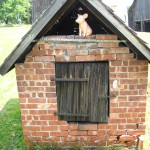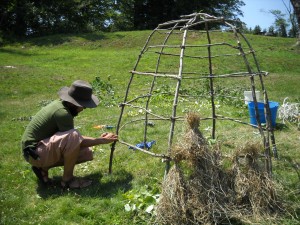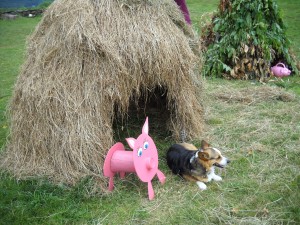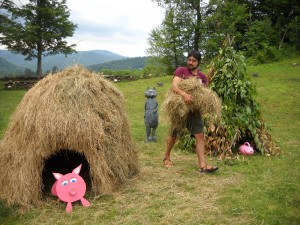Garden Wimsy
If you ask my grandchildren, they would probably tell you that “Silly” is my middle name. George may remember the time Grampy showed up at his house wearing one red high-top sneaker, one purple. Or Casey might tell you about the Superman cape on the scarecrow that is currently in my garden. So they were not surprised to see that, with some help, I have put together a full-sized representation of the story of the Three Little Pigs, complete with pigs and a wolf. I love garden whimsy, and encourage you to think about creating outdoor art for your own garden. It doesn’t take great skills to create something fun.
This particular whimsy is on public display in Woodstock, Vermont at the Vermont Land Trust offices on Hunt Farm Rd, off Rose Hill Rd. It is part of an event called Bookstock – a one day event that has already passed by. But the Poet’s Trail, which is under the auspices of Bookstock, will continue into the fall, overlapping with Sculpture Fest which is held nearby. It features poems by Mary Oliver selected by Woodstock High School students that are posted along the trail, and lots of fabulous sculpture along the trail, in the fields, and around the old farmhouse. There’s a little whimsy, too.
At the farm there is a tiny old brick building (just 5 feet square and 6 feet tall) built long ago to store ashes, presumably for making soap. Charlet Davenport, the organizer of the Poet’s Trail event, told me she thought the brick house would be great as part of the Three Pigs story, but needed someone to build a straw house and a stick house. I agreed to do so.
I built the houses with the help of my summer intern, Gordon Moore. They are circular and 6 feet in diameter at the base. The straw house has a rounded top and the stick house is built like a teepee.
The houses are made with freshly cut saplings, each an inch or two in diameter and 8 feet long. We stripped off side branches and leaves, and then dug 6-inch deep holes for each sapling. After placing the sticks in the holes we tied them together at the top using copper wire that we stripped out of scrap #14 building wire that I had left over from the days when I was an electrician.
For the straw house we bent over opposing sticks, overlapping them and tying them together for a foot or more, creating a domed top. For the stick house we tied 3 together as if we were building a teepee, then added 3 more in between the first three. Once that was done, we filled the holes in the ground with soil and some gravel to firm it up and keep each stick in place – just in case a wolf wanted to huff and puff at our pig homes.
Then the real work began. We took small diameter sticks (half to quarter-inch) and tied them around the outside of the houses with wire. We did 5 or 6 concentric circles descending around the outside of our little pig houses. That provided stability and places for us to tie on bundles of straw (actually, we used hay, not straw, nearly 2 bales of it) or clumps of twigs with the leaves left on. We needed to create something that enclosed our structure but was not so solid as to deter the mythological wolf.
For the straw house we tied more than 150 clumps of hay. We used ordinary 3-stranded garden twine, which was strong enough to tie our bundles together without breaking when we cinched them together. For the stick house we made similar bundles, using the side branches, leaves and all, that we had cut off our saplings that we used for the framework. The stick house was easier – we could make 2-foot long bundles that quickly covered the exterior of the stick house. I found that using a knot I learned in Boy Scouts, a clove hitch, to tie the bundles together worked best.
I had a nice pig watering can (made of plastic) and a ceramic piggy bank, but needed a good-sized pig for the straw house. My partner, Cindy Heath, sketched out the face and front legs of a pig onto a piece of quarter-inch birch plywood, and I cut it out with a jig saw. Then we made the back end of the pig, and I screwed each end onto a short pine log about 6 inches in diameter. We painted it pink, Cindy painted on eyes, and I attached a tuna can for a snout. It looked great – and undoubtedly tasty to passing wolves.
I called the former mayor of Hanover, Marilyn “Willy” Black to ask if I might borrow a wolf. She is a chainsaw artist, and agreed to lend me the original wolf she made many years ago. She re-painted it, and I installed it in a menacing pose behind the houses. Beware, pigs!
All together Gordon and I spent about 15 hours each making the 2 houses, and Cindy and I spent another hour each on the pig.
One could look at this as a colossal waste of time, or perhaps as a worthy endeavor – given that this exhibit will create plenty of smiles and a few giggles from my grandkids. Think about creating something fun (or silly) for your own garden – especially if you have kids or grandchildren.
Henry’ Homeyer lives and works in Cornish Flat, NH. You may write him at P.O. Box 364, Cornish Flat, NH 03746 or henry.homeyer@comcast.net.







